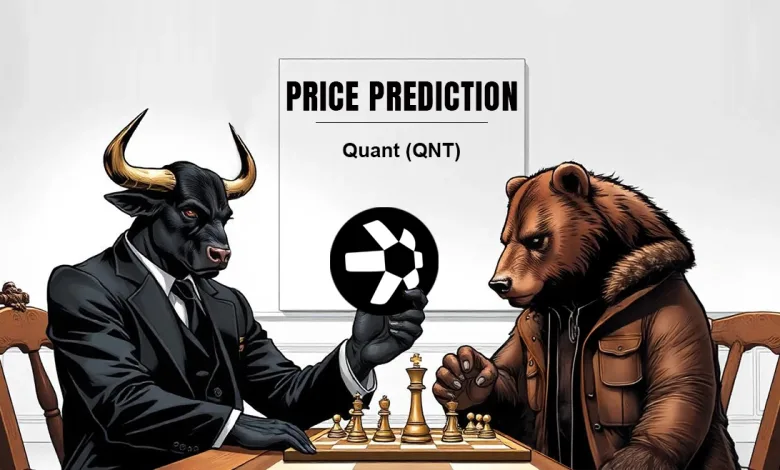Quant Price Prediction 2025-2035: Will It Hit $1,500 by 2035?

- QNT rebounds from the $59.08 support zone, proving its strength amid market turbulence.
- Whales show 0.00% change in activity, indicating potential long-term confidence in QNT.
- QNT could surge between $10 and $300 in 2025, fueled by post-halving bullish momentum.
Quant (QNT) Overview
| Cryptocurrency | Quant |
| Ticker | QNT |
| Current Price | $90.87 |
| Price Change (30D) | +46.06% |
| Price Change (1Y) | -8.61% |
| Market Cap | $1.09 Billion |
| Circulating Supply | 12.07 Million |
| All-Time High | $428.38 |
| All-Time Low | $0.1636 |
| Total Supply | 14.88 Million |
What is Quant (QNT)?
Quant is a blockchain interoperability protocol and the creator of Overledger, the world’s first DLT operating system. Founded in 2015 by Gilbert Verdian, a cybersecurity expert with experience in government and healthcare, the Quant Network was built to streamline the flow of information across siloed systems using blockchain technology. Verdian envisioned Overledger as a way to securely link various blockchains and legacy systems, without requiring modifications to their underlying architecture.
How Does Quant Work?
At the core of Quant is Overledger, an API-based DLT gateway that allows developers and enterprises to interact with multiple blockchains simultaneously, without needing to write blockchain-specific code. It enables the development of mDApps (multi-chain decentralized applications), which are not restricted to a single ledger like traditional DApps.
Overledger is built with a four-layer architecture, each serving a distinct function:
- Transaction Layer
Stores validated transactions for each blockchain individually. This layer keeps ledgers independent but usable within a broader system. - Messaging Layer
A shared channel that collects transaction metadata, smart contract data, and messages from various ledgers. - Filtering and Ordering Layer
Filters and sorts messages based on specific rules and ensures they meet application requirements. - Application Layer
This top layer hosts mDApps, which can interact with other apps and ledgers through predefined rules while remaining logically separate.
This architecture allows for secure, scalable, and future-proof cross-chain communication without requiring changes to each blockchain’s existing consensus mechanisms.
Key Features of Quant
- Overledger DLT Gateway
Enables communication across public and private blockchains without requiring custom integrations. - REST API Access
Developers use familiar web protocols to connect with different ledgers, minimizing the need for learning blockchain-specific development environments. - mDApps Support
Multichain apps can be created that utilize multiple blockchain networks, enabling broader use cases across industries like finance, supply chain, and healthcare. - Multi-DLT Smart Contracts
Allows for complex cross-chain transactions like atomic swaps, which let users exchange tokens across chains without relying on intermediaries.
What is the QNT Token?
QNT is an ERC-20 utility token used within the Quant ecosystem. Although built on Ethereum, it’s blockchain-agnostic and can migrate to other platforms if needed. It plays several roles:
- Access and Licensing: Developers need QNT to access Overledger. Licenses are paid in fiat and converted to QNT by the Quant Treasury.
- Ecosystem Participation: End users require QNT to use mDApps and renew their license keys annually.
- Developer Monetization: App creators can monetize their mDApps using QNT, fiat, or other digital assets.
- Regulatory Compliance: QNT is classified by FINMA as a utility token, ensuring compliance with Swiss financial regulations.
Quant Price History
After a quiet two-year accumulation phase after launch, QNT launched into a historic rally, soaring nearly 260,000% to reach its all-time high of $428.38. This parabolic rise marked the end of accumulation, but a sharp correction followed.
The token dropped over 90%, settling into a key support zone between $59.08 and $41.63. This level has acted as a crucial floor multiple times, sparking recoveries, most notably in Q4 2022, when QNT climbed back to $223.59.
However, it met strong resistance between $227.85 and $202.45, a region reinforced by the 50% Fibonacci retracement level at $212.76. Since then, QNT has remained trapped in a descending channel, forming lower highs while repeatedly testing the same support range.
Each bounce hints at bullish potential, but the structure remains technically bearish in the short term. Recently, QNT has again rebounded from support, and the monthly candle shows bullish momentum. If this momentum holds, QNT could challenge the upper boundary of the descending channel.
A breakout here could reopen the path toward the resistance zone near $227, and possibly even a retest of the all-time high in the long run. However, failure to maintain this upward move could send QNT back to its familiar support. A breakdown below that range would be a strong bearish signal, potentially dragging the token toward its 2018 lows.
Whales Hold Steady as QNT Awaits Its Next Big Move
In crypto, silence can be just as telling as noise. Recent on-chain data for Quant (QNT) reveals an intriguing pattern: the whales holding the lion’s share of the token are in a low-activity phase, quietly maintaining their positions as the market moves cautiously around them.
According to data from IntoTheBlock, just seven whale addresses hold a massive 50.71% of the total QNT supply, equal to roughly 12.39 million tokens. Yet despite their weight in the ecosystem, these major players haven’t budged—whale holdings remain unchanged over the past 30 days (+0.00%).
This inactivity isn’t random. It suggests a watch-and-wait approach by large holders, likely waiting for the right market conditions to make their next move. They’re not accumulating, but they’re also not exiting. In a market known for high volatility and sudden shifts, this level of calm signals confidence—or careful calculation.
The historical concentration chart backs this up. While retail and investor addresses have seen minor activity shifts, with retail growing slightly at +0.49% and investors dipping -0.76%, whales continue to anchor the token’s supply without triggering major changes in distribution.
For now, QNT’s most oversized holders seem content to observe, not act. But in crypto, that stillness can be the calm before a storm. Whether the next move is up or down, one thing is clear: when whales decide to swim again, the ripple effects could be massive.
Related: Flow Price Prediction 2025-2035: Will It Hit $200 by 2035?
Yearly Highs and Lows of Quant
| Year | Quant Price | |
| High | Low | |
| 2024 | $171.710 | $50.258 |
| 2023 | $161.850 | $0.053 |
| 2022 | $223.549 | $41.630 |
| 2021 | $428.38 | $10.285 |
| 2020 | $17.341 | $1.421 |
| 2019 | $15.594 | $1.217 |
| 2018 | $5.026 | $0.1636 |
Quant Technical Analysis
The MACD for QNT is currently bearish, with the MACD line at -6.20 below the signal line at -4.964. This suggests declining momentum and increasing downside risk. Reinforcing this trend shift, the MACD histogram has turned red, showing growing divergence between the two lines, indicating that selling pressure is intensifying.
In contrast, the Relative Strength Index (RSI) shows early signs of bullish potential. It currently stands at 45.29, and its trajectory moves vertically upward, signaling a possible momentum shift from bearish to neutral or bullish. While still below the neutral 50 level, the RSI’s upward movement indicates buyers are beginning to step in, potentially limiting further losses.
Quant (QNT) Price Forecast Based on Fair Value Gap
The Fair Value Gap (FVG) visible on the QNT monthly chart spans approximately $265.22 to $228.16, marking a key imbalance area left behind during the rapid decline from the 2021 all-time high. This zone now acts as a possible resistance, where unfilled orders from the previous move could trigger selling pressure if revisited.
Fair Value Gaps often serve as magnetic zones for price, returning it to “rebalance” supply and demand. While QNT trades nearly 70% below this gap, historical price behavior suggests that if bullish momentum continues, the FVG may become a medium-term target.
Quant (QNT) Price Forecast Based on MA Ribbon Analysis
The 20-period moving average (MA) for QNT is currently at $93.416, sitting below the 50-period MA at $111.699, and both are positioned above the current price. This structure signals a bearish trend, with both MAs acting as dynamic resistance zones, capping any upward movement.
A price trading below both the short—and mid-term moving averages typically reflects ongoing selling pressure and a lack of bullish momentum. The 20 MA dipping below the 50 MA further confirms a death cross scenario on the monthly chart, which is often considered a long-term bearish signal by traders and institutions.
Historically, QNT has struggled to sustain moves above the 20 MA when trending downward. The price’s repeated rejection from this level reinforces its strength as resistance. However, a strong recovery would require QNT to reclaim the 20 MA and sustain above the 50 MA.
Quant (QNT) Price Forecast Based on Fib Analysis
Quant (QNT) trades below the 23.60% Fibonacci retracement level at $100.47. This level now acts as the first major resistance, as price action struggles to reclaim higher ground following its decline from its all-time high.
If QNT initiates a bullish move and surpasses the 23.60% level, the next resistance lies at the 38.20% level, at $162.52. This zone has previously acted as a barrier during failed recovery attempts and could see renewed selling pressure.
Beyond that, the 50.00% Fibonacci level at $212.67 marks a critical midpoint, coinciding with past price rejection zones and offering a highly watched target for bulls. A successful break above this region could open the path to the 61.80% retracement level at $262.83, another area aligned with historical congestion.
The final major resistance is 78.60%, or $334.23, just below the all-time high zone. On the other hand, the 0% level, placed near $0.16, remains the ultimate historical support.
Quant (QNT) Price Prediction 2025
The market is projected to surge in 2025 following the 2024 Bitcoin halving. With renewed investor enthusiasm and a wave of institutional capital entering the space, QNT could see explosive growth. During this peak phase, QNT is forecasted to trade between $10 and $300.
Quant (QNT) Price Prediction 2026
As the excitement cools, 2026 may usher in a market correction. A typical post-peak phase, this year could bring declining prices across most digital assets. For QNT, this could mean a retracement to around $100 to $250, as investors take profits and reassess market conditions.
Quant (QNT) Price Prediction 2027
By 2027, the market may reach its bottom, marking the final stage of the correction cycle. QNT could hit its lowest point in this period, possibly falling to $50 to $200. However, this year also typically signals the start of a slow and steady recovery, with long-term investors beginning to re-enter the market in anticipation of the next halving cycle.
Quant (QNT) Price Prediction 2028
The recovery will likely gain traction in 2028 as the industry eyes the fifth Bitcoin halving. Renewed interest in crypto could lift QNT’s price to a range of $250 to $450, reflecting growing optimism and increased participation in the market.
Quant (QNT) Price Prediction 2029
By 2029, as post-halving excitement peaks and market confidence returns, QNT could enter a new growth phase, supported by rising blockchain adoption and institutional demand. Prices could range between $400 and $600.
Quant (QNT) Price Prediction 2030
In 2030, a healthy market correction is anticipated as investors begin to take profits after strong gains. QNT may retrace to levels between $300 and $500, though the correction is expected to be moderate, with investor confidence largely intact.
Quant (QNT) Price Prediction 2031
The year 2031 is expected to stabilize the crypto market, with renewed interest in utility-driven projects like Quant. Consequently, QNT could steadily rise, trading between $350 and $550, fueled by adoption growth and expanding real-world blockchain use cases.
Quant (QNT) Price Prediction 2032
A major upswing is expected in 2032 as the sixth Bitcoin halving drives market enthusiasm. QNT could surge significantly, benefiting from increased attention and market expansion, with its price reaching $500 to $800.
Quant (QNT) Price Prediction 2033
The post-halving rally is likely to intensify in 2033. This period could mirror the bullish trend seen in 2025, pushing QNT to new highs as it trades between $700 and $1,000, fueled by innovation, adoption, and institutional entry.
Quant (QNT) Price Prediction 2034
As in past cycles, 2034 might bring a modest correction after two years of strong gains. While not as sharp as in 2026, this cooling phase could see QNT adjust to $650 to $900, as the market digests previous growth and rebalances.
Quant (QNT) Price Prediction 2035
Finally, 2035 is expected to be a powerful recovery year, driven by growing regulatory clarity, rising global adoption, and excitement ahead of the 2036 Bitcoin halving. QNT may rally to new all-time highs, trading between $950 and $1,500, reaffirming its long-term potential as a cornerstone of blockchain interoperability.
Related: DEEP Price Prediction 2025-35: Will It Hit $15 by 2035?
FAQs
QNT is Quant Network’s utility token. It powers Overledger, a blockchain interoperability protocol that enables seamless cross-chain communication for businesses and developers.
You can buy QNT using fiat or other cryptocurrencies like BTC or ETH through major cryptocurrency exchanges like Binance, Coinbase, or Kraken.
QNT shows strong long-term potential due to its enterprise adoption, unique technology, and projected growth through upcoming crypto market cycles.
Store QNT in a secure hardware wallet like Ledger or Trezor, or use reputable software wallets that support ERC-20 tokens.
Quant Network was founded in 2015 by Gilbert Verdian, a cybersecurity expert with experience in government and healthcare systems.
QNT was launched in 2018 and began gaining attention for its unique approach to blockchain interoperability.
QNT’s current circulating supply is approximately 12.07 million tokens out of a total supply of 14.88 million.
QNT is projected to surpass its all-time high of $428.38, especially during peak market phases following Bitcoin halving cycles.
QNT’s all-time low was $0.1636, recorded in 2018 during its early trading period.
QNT is forecasted to trade between $10 and $300 in 2025, driven by post-Bitcoin halving momentum and renewed investor demand.
In 2028, QNT could rise to $250–$450 as interest builds ahead of the fifth Bitcoin halving and market recovery gains momentum.
QNT may range between $300 and $500 in 2030, reflecting a market correction phase after strong previous growth years.
QNT is expected to surge to $500–$800 in 2032, driven by hype and optimism around Bitcoin’s sixth halving and growing adoption.
In 2035, QNT may reach $950–$1,500, supported by mainstream adoption, regulatory clarity, and anticipation of the 2036 Bitcoin halving.





